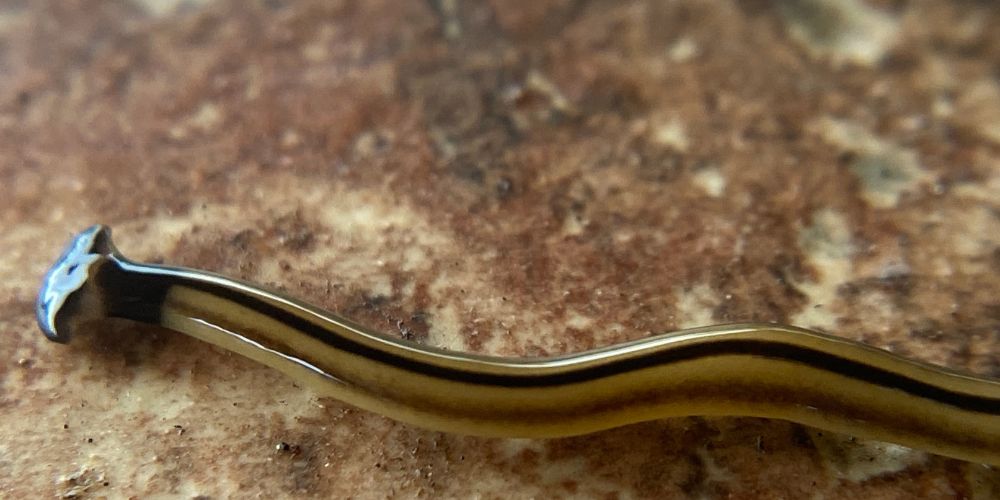Hammerhead Worms May Be Headed To A Yard Near You

The past few years have been full of creepy crawlies. First it was murder hornets, then spongy moth caterpillars, mass amounts of cicadas and, most recently, hammerhead worms. But what exactly are hammerhead worms, and why are they such a big problem?
Hammerhead Worms Are Headed This Way
The unwelcome arrival of hammerhead worms in Ontario has inched its way closer. While technically not an insect, these invasive invertebrates, have been spotted slithering through Kitchener, Hamilton, and Newmarket.
There haven't been any observations in Simcoe County, at least according to observations on on iNaturalist, an invasive species platform. But chances are it won't be long until these toxic worms wiggle their way to our backyards.
Why Hammerhead Worms Are A Problem
Originally from Southeast Asia, lab biologists believe the hammerhead worm was brought into the province in nursery plant stock. Their distinctive, flattened heads give them a striking appearance, but these worms are far from harmless.
One of the biggest concerns is their ability to secrete a potent neurotoxin called tetrodotoxin—the same toxin found in pufferfish. While the amount present in a single worm isn't enough to be deadly to humans, their mucus can cause skin irritation. If you encounter a hammerhead worm, it's best to avoid touching it with bare hands. Experts recommend using gloves or a shovel to handle them safely.
Pets are also at risk. If a dog or cat comes into contact with or ingests one of these worms, they may experience swelling, pain, and stomach upset. Pet owners should keep an eye out for these worms in gardens and outdoor spaces.
Environmental Impact of Hammerhead Worms
While the toxin in hammerhead worms poses some concern for humans and pets, the real threat is their impact on the environment. These invasive predators have a voracious appetite for earthworms, which are essential for maintaining healthy soil and nutrient cycling.
Earthworms play a crucial role in aerating the soil, breaking down organic matter, and improving plant growth. Their decline can have a domino effect on ecosystems, potentially leading to degraded soil quality, poor plant health, and disruptions in the food chain.
Additionally, hammerhead worms reproduce asexually, meaning they don’t need a mate to multiply. Even worse, they're regenerative, which means cutting them in half doesn’t kill them ... it simply creates more worms. This makes them incredibly difficult to control and eradicate once they establish themselves in an area.
How To Help
How can you help with the hammerhead worm problem?
Be vigilant! The best way to combat the hammerhead worm invasion is through awareness and early detection.
If you spot a flat, ribbon-like worm with a broad head in your garden, report it to the Ministry of Natural Recourses and Forestry online through the Early Detection and Distribution Mapping System. The invasive Species Centre also recommends using iNaturalist for reporting new sightings. This app is used by scientists and conservationists to track the movement and population of species.
RELATED: Check out Barrie 360's list of free identifier apps for birds, bugs, plants and more ...
Disposing Of Hammerhead Worms
If you encounter a hammerhead worm, proper disposal is crucial to prevent them from multiplying:
- Dispose of the bag in your household garbage – do not compost or release it elsewhere.
- Do not cut the worm – this will only cause it to regenerate and create more worms.
- Pick it up using gloves or a shovel, avoiding direct skin contact.
- Place the worm in a sealable plastic bag with salt or vinegar, which will kill it.
- Leave the sealed bag in direct sunlight to ensure it is fully dead.
The Road Ahead
While hammerhead worms have yet to be officially documented in Simcoe County, their presence in nearby regions means it’s only a matter of time before they arrive. With their ability to disrupt ecosystems and reproduce rapidly, early detection and proper disposal will be key in preventing them from taking hold in local environments.
By staying informed, reporting sightings, and taking the necessary precautions, we can help slow the spread of these invasive predators and protect our local wildlife and ecosystems.
Beat FOMO by being in the know!
Sign up for our newsletter today and never miss a beat.





